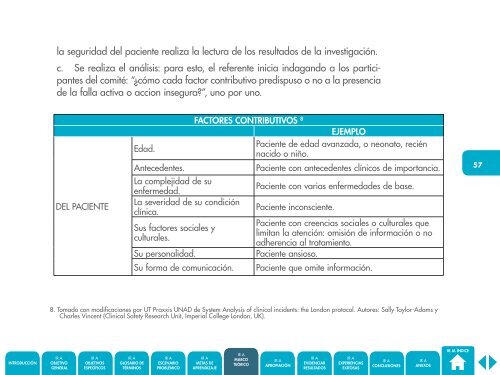Evaluar-frecuencia-eventos-adversos
Evaluar-frecuencia-eventos-adversos
Evaluar-frecuencia-eventos-adversos
- No tags were found...
Create successful ePaper yourself
Turn your PDF publications into a flip-book with our unique Google optimized e-Paper software.
la seguridad del paciente realiza la lectura de los resultados de la investigación.c. Se realiza el análisis: para esto, el referente inicia indagando a los participantesdel comité: “¿cómo cada factor contributivo predispuso o no a la presenciade la falla activa o accion insegura?”, uno por uno.DEL PACIENTEEdad.Antecedentes.La complejidad de suenfermedad.La severidad de su condiciónclínica.Sus factores sociales yculturales.Su personalidad.Su forma de comunicación.FACTORES CONTRIBUTIVOS 8EJEMPLOPaciente de edad avanzada, o neonato, reciénnacido o niño.Paciente con antecedentes clínicos de importancia.Paciente con varias enfermedades de base.Paciente inconsciente.Paciente con creencias sociales o culturales quelimitan la atención: omisión de información o noadherencia al tratamiento.Paciente ansioso.Paciente que omite información.578. Tomado con modificaciones por UT Praxxis UNAD de System Analysis of clinical incidents: the London protocol. Autores: Sally Taylor-Adams yCharles Vincent (Clinical Safety Research Unit, Imperial College London, UK).INTRODUCCIÓNIR AOBJETIVOGENERALIR AOBJETIVOSESPECÍFICOSIR AGLOSARIO DETÉRMINOSIR AESCENARIOPROBLÉMICOIR AMETAS DEAPRENDIZAJEIR AMARCOTEÓRICOIR AAPROPIACIÓNIR AEVIDENCIARRESULTADOSIR AEXPERIENCIASEXITOSASIR ACONCLUSIONESIR AANEXOSIR AL ÍNDICE


